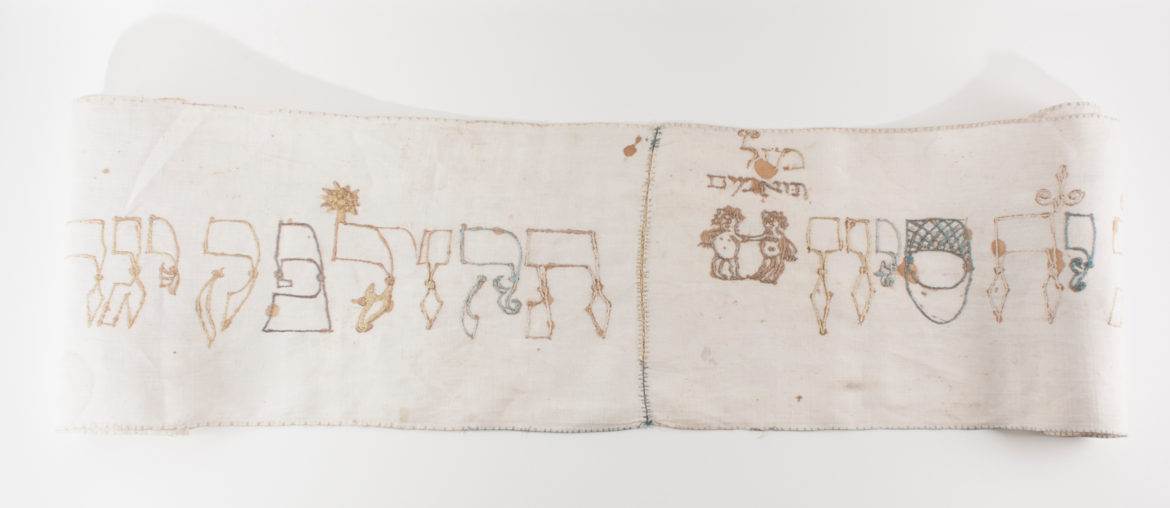Rebecca Forgasz was the Director & CEO of the Jewish Museum of Australia for nearly ten years. This extract of her farewell lecture, Ten tantalising tales: stories from our collection, is part of a series published here to mark the High Holidays. In each instalment Rebecca reflects on the personal, collective and cultural significance of objects and the collections that house them.
Ten Tantalising Tales #5 Wimpel
Just close by to the Yemenite headdress in this display case about Torah, we find this unassuming little textile object – a Torah binder or wimpel. In Germany it became customary in the second half of the 16th century to prepare a binder for the Torah scroll on the occasion of the birth of a son. This binder was usually made by the child’s mother or grandmother from the cloth used to swaddle the baby boy during the circumcision ceremony. The baby’s name, his father’s name and his date of birth were embroidered or written on the cloth. It would be brought to the synagogue when the boy was three years old – the age at which, according to tradition, he was ready to start learning Torah (or, others say, when he was toilet trained!). The boy with help of father would wrap the binder around the Torah. The binder would be used again to bind the Torah scroll at the boy’s bar mitzvah and other important occasions through his life.
This particular wimple is inscribed in Hebrew “Abraham ben Zev, may he live a good life, born with good fortune on Tuesday the 18th of Sivan, 1747. May he grow to study Torah, to come to the chuppah and excel in good deeds” (the blessing said at the brit milah ceremony). The fantastical figures and zodiac sign are typical of German wimpels. I feel a special connect to this one because it has the zodiac sign of the twins or Geminim which is also my star sign!
As many of you would know, issues of gender in Judaism have always been of great interest to me, and the subject of my academic research. I remember when I first learnt about these wimpels, they struck me as being really significant from a feminist perspective. They represented an opportunity for women’s presence to be inserted, almost surreptitiously, into the ritual space of synagogue, from which they were otherwise excluded.They represented an opportunity for women’s presence to be inserted, almost surreptitiously, into the ritual space of synagogue, from which they were otherwise excluded. Women’s handiwork, and their love for their children, found a place in the very centre of male-dominated Jewish ritual.
When I was doing some research for this presentation, I came across an article by an American rabbi and scholar Dr Barbara Thiede which elaborates this idea and places it in historical context. She believes that the custom of making these wimpels can be traced back to the time that Ashkenazi rabbis legislated to remove women from the brit milah ceremony in the 13th century. She says: “The Maharam, Rabbi Meier b. Barukh of Rothenburg, ruled that it was improper for a woman to sit among men at a circumcision. In the next century, the Maharil concurred. Confirming male status in the covenant required a celebration of maleness. Women were excluded.
“Ashkenazic Jewish women, however, cleverly reinserted themselves in the ritual and related observances, creating customs and practices that gave them a significant – sometimes even a public – role. They cleaned and cut the cloth used either to bind the infant’s feet or to catch drops of blood, embroidered and decorated a blessing onto the fabric, and presented the wimple to their communities in a public, liturgically embedded ceremony. Cloth from a circumcision was repurposed to serve as a tool for a sacred task: binding and wrapping the Torah scroll.
“Sixteenth-century Jewish women sidestepped their rabbis in an audacious act of spiritual ingenuity. Banned from the rite of brit milah, they used the wimpel to reestablish their presence by introducing a new liturgical practice. . . Women’s artistry, artistry created from the rite of brit milah, was on display for the entire congregation. . . The rabbis could legislate the exclusion of women from Jewish ritual, liturgy, or practice. The women, in turn, could find their way right back in.”


Comments are closed.